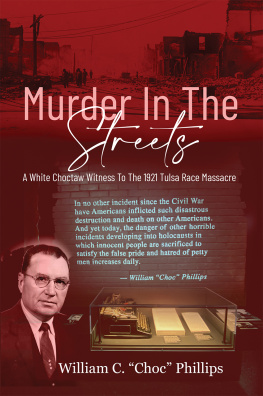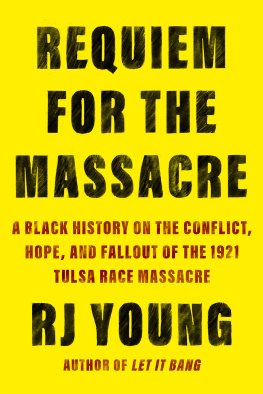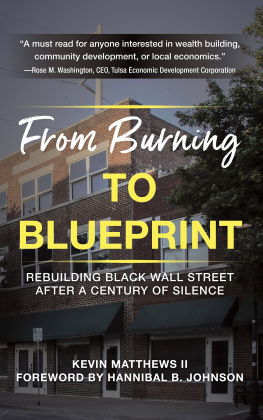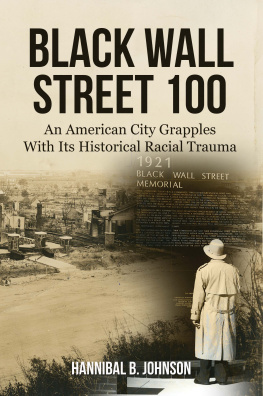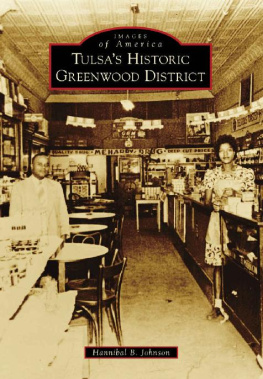
For the victims and survivors of the Tulsa Race Massacre of 1921
and
the Greenwood District
Contents
By the time Id reached fourth grade, the lesson I dreaded most was our history unit on slavery.
I attended a predominantly white school in a predominantly white Missouri town, and more often than not, I felt like I fit in well enough. Some people went out of their way to point out my differences, like my highly textured hair that would curl and thicken at the scalp when my chemical relaxer started to grow out. Or theyd hold their arm up to mine when theyd gotten a particularly good tan, showing me that they were almost as dark as me. There were other microaggressions, of courseway too many to name here. It was southwest Missouri, and it was the 1980s. Racial sensitivity wasnt high on most peoples list of priorities.
History class felt uninspired and repetitive for much of the year, but the few days we spent learning about Black Americans were excruciating. I was embarrassed when our teachers talked about the African people whod been stolen from their continent and brought to the United States to be part of a chattel slavery system; I didnt like the way both the teachers and the textbooks talked about enslaved people as if they werent actual human beings with hopes and dreams and emotions and profound mental strength. I also didnt like that heads automatically swiveled to find me, to see how I was reacting to the lesson because I was one of the only Black people theyd ever met in their entire lives.
And, in retrospect, I hated that the room was uncomfortably silent during the lesson; that nobody asked why we never learned about anyone apart from basic biographies of Frederick Douglass and Harriet Tubman; that no actual countries in Africa were ever named, which is likely why so many Americans still think Africa is a country rather than a continent; and that the lesson never explicitly stated how much the violent, genocidal foundation of this country shaped everything about how our nation operates today.
Perhaps the most insulting part about the units covering centuries of Black history is that they were so briefwe spent maybe a week on the topic, if that. Reconstruction was never explained in a meaningful way. The civil rights lesson was, again, focused on sanitized versions of two people: Rosa Parks and Dr. Martin Luther King Jr. I never came across the names of voting rights activists Fannie Lou Hamer or Stokely Carmichael or John Lewis in our textbooks. And I cant remember one mention of Shirley Chisholm, the first Black woman elected to Congress, as well as the first woman and Black woman to run for a major political partys nomination for president of the United States.
The fact that there was no separate, detailed lesson about the Trail of Tears, which ran right through our hometown, was particularly egregious.
I blame the history texts more than my individual teachers. For the most part, I know the curriculum was not up to them. And I know that some of them, all white women and men, were inherently uncomfortable teaching lessons about such traumatic times in our countrys history. But all these years later, after meeting so many dedicated, progressive, and passionate educators around the country, I have to wonder: Why didnt just one of my teachers care enough to go off script? To sit in their discomfort so we could have honest conversations about our past? To not only challenge us to learn more but to challenge themselves as well?
When you are a Black person from Missouri, most people assume you grew up in St. Louis, which is nearly 50 percent Black. Or maybe Kansas City, with a population thats just under 30 percent African American. Ive shocked many people when I tell them that Im from Springfield, the third-largest city in the state, whose nickname is the Queen City of the Ozarks. (City is a generous word. When I was growing up, Springfield felt more like a big town, and even in 2019, the population was just over 167,000.) Springfield was about 3 percent Black during my childhood and teenage years, in the 1980s and 90s, and the demographics havent changed much since then. I didnt know about percentages when I was younger, but I did know that besides the Black church my family and I attended each week, I seldom saw other Black people outside my home.
Just a few weeks after I started second grade, my parents moved my brother and me to the south side of town, which was almost exclusively white. Ill never forget walking into my new classroom; every set of eyes that stared back at me came from a white face. The principal was white, my teachers were white, and for the majority of my time in elementary school, I was the only Black girl in my class. Junior high seemed a bit more promising; there were, at least, a handful of Black kids in my seventh-grade class. But people moved away or went to different schools, and that number didnt increase by much in high school.
It never occurred to me to wonder why the town was so white. It just was. But the older I got, I did start to wonder why my parents had chosen to live there. Sure, Springfield was affordable. Theyd bought their first house together there, renovated part of it, and then bought their second home when I was seven years old. But why Springfield in particular?
My parents, who once would have been described as Black people who pulled themselves up by their bootstraps, had grown up in Jim Crow Arkansas, thirty minutes from the town of Elaine, which, according to the New York Times, suffered one of the worst episodes of racial violence in American history, in 1919. (My mother recently told me that some of our ancestors migrated from Elaine in the decades following the massacre to the town where she grew up, and I have to wonder if they had been there to see the destruction and violence that took over their town.) My mom and dad grew up in poor farming families; they worked from a young age picking cotton in their parents fields and shared beds with their many siblings. My mother is one of thirteen kids, my father one of ten.
I was in my twenties before I really comprehended my parents origin story in the Ozarks. I learned that, after a brief stint in Louisville, Kentucky, my fathers job at an electronics company transferred him to Springfield, Missouri, in the early 1970s. And that, once they arrived, they had so much trouble renting an apartment that my father had to ask his white supervisor to cosign the rental applicationnot because they were so young, but because they were Black. Fifteen years later, when they moved us to the white side of town, we were the first Black family to integrate our solidly middle-class street.
We traveled by car more often than plane, and when we did fly, it was usually out of the tiny airport in Springfield. But, if the price was right, wed drive the three hours north to fly out of St. Louis or Kansas City. And, sometimes, wed travel three hours southwest to fly out of Tulsa, Oklahoma.
I dont remember much about the Tulsa of my childhood; I probably didnt see much more than airport terminals, restaurants, and hotels. But when I drove cross-country to and from Los Angelestwice in my twenties and once in my thirtiesI never minded stopping in Oklahoma. Tulsa was a town where, as a young Black woman traveling alone, I was unafraid to stop for snacks or to fill up my gas tank, especially compared to the long line of conservative areas I had to travel through on that route.



